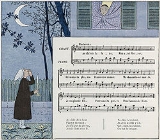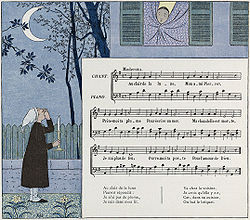
Au Clair de la Lune
Encyclopedia

French language
French is a Romance language spoken as a first language in France, the Romandy region in Switzerland, Wallonia and Brussels in Belgium, Monaco, the regions of Quebec and Acadia in Canada, and by various communities elsewhere. Second-language speakers of French are distributed throughout many parts...
folk song
Folk music
Folk music is an English term encompassing both traditional folk music and contemporary folk music. The term originated in the 19th century. Traditional folk music has been defined in several ways: as music transmitted by mouth, as music of the lower classes, and as music with unknown composers....
of the 18th century. The author is unknown. Its simple melody
Melody
A melody , also tune, voice, or line, is a linear succession of musical tones which is perceived as a single entity...
is commonly taught to beginner students of the glockenspiel
Glockenspiel
A glockenspiel is a percussion instrument composed of a set of tuned keys arranged in the fashion of the keyboard of a piano. In this way, it is similar to the xylophone; however, the xylophone's bars are made of wood, while the glockenspiel's are metal plates or tubes, and making it a metallophone...
, as it provides an easy way for students to become comfortable with how notes are played on their instrument.
Lyrics

Double entendre
A double entendre or adianoeta is a figure of speech in which a spoken phrase is devised to be understood in either of two ways. Often the first meaning is straightforward, while the second meaning is less so: often risqué or ironic....
throughout (the dead candle, the need to light up the flame, the God of love, etc.) that becomes clear with its conclusion.
- Au clair de la lune
- Mon ami PierrotPierrotPierrot is a stock character of pantomime and Commedia dell'Arte whose origins are in the late 17th-century Italian troupe of players performing in Paris and known as the Comédie-Italienne; the name is a hypocorism of Pierre , via the suffix -ot. His character in postmodern popular culture—in...
- Prête-moi ta plume
- Pour écrire un mot
- Ma chandelle est morte
- Je n'ai plus de feu
- Ouvre-moi ta porte
- Pour l'amour de Dieu
- Au clair de la lune,
- Pierrot répondit :
- « Je n'ai pas de plume,
- Je suis dans mon lit.
- Va chez la voisine,
- Je crois qu'elle y est,
- Car dans sa cuisine
- On bat le briquet. »
- Au clair de la lune,
- L'aimable Lubin;
- Frappe chez la brune,
- Elle répond soudain :
- -Qui frappe de la sorte ?
- Il dit à son tour :
- -Ouvrez votre porte,
- Pour le Dieu d'Amour.
- Au clair de la lune,
- On n'y voit qu'un peu.
- On chercha la plume,
- On chercha le feu.
- En cherchant d'la sorte,
- Je n'sais c'qu'on trouva ;
- Mais je sais qu'la porte
- Sur eux se ferma..
In English:
- By the light of the moon
- My friend PierrotPierrotPierrot is a stock character of pantomime and Commedia dell'Arte whose origins are in the late 17th-century Italian troupe of players performing in Paris and known as the Comédie-Italienne; the name is a hypocorism of Pierre , via the suffix -ot. His character in postmodern popular culture—in...
- Lend me your pen
- To write a word
- My candle is dead
- I have no more fire
- Open your door for me
- For the love of God
- By the light of the moon,
- Pierrot replied
- I don't have any pen,
- I'm in bed
- Go to the neighbor's,
- I think she's there
- Because in her kitchen
- Someone is using the lighter
- By the light of the moon
- likable Lubin
- Knocks on the brunette's door
- she soon responds
- Who's knocking like that?
- He then replies
- Open your door
- for the God of Love!
- By the light of the moon
- One could barely see
- The pen was looked for
- The light was looked for
- With all that looking
- I don't know what was found
- But I do know that the door
- Was shut behind them.
In classical music
19th-century French composer Camille Saint-SaënsCamille Saint-Saëns
Charles-Camille Saint-Saëns was a French Late-Romantic composer, organist, conductor, and pianist. He is known especially for The Carnival of the Animals, Danse macabre, Samson and Delilah, Piano Concerto No. 2, Cello Concerto No. 1, Havanaise, Introduction and Rondo Capriccioso, and his Symphony...
quoted the first few notes of the tune in the section The Fossils, part of his famous suite The Carnival of the Animals
The Carnival of the Animals
Le carnaval des animaux is a musical suite of fourteen movements by the French Romantic composer Camille Saint-Saëns. The orchestral work has a duration between 22 and 30 minutes.-History:...
.
1860 recording
In 2008, a phonautographPhonautograph
The phonautograph is the earliest known device for recording sound. Previously, tracings had been obtained of the sound-producing vibratory motions of tuning forks and other objects by physical contact with them, but not of actual sound waves as they propagated through air or other media. Invented...
paper recording made by Édouard-Léon Scott de Martinville
Édouard-Léon Scott de Martinville
Édouard-Léon Scott de Martinville was a French printer and bookseller who lived in Paris. He invented the earliest known sound recording device, the phonautograph, which was patented in France on 25 March 1857....
of Au Clair de la Lune on April 9, 1860 was digitally converted to sound by U.S. researchers. This one-line excerpt of the song was widely reported to have been the earliest recognizable record of the human voice and the earliest recognizable record of music.
According to those researchers, the phonautograph recording contains the beginning of the second verse of the song, "Au clair de la lune, Pierrot répondit...". It has also been reported that the recording contains the beginning of the song, "Au clair de la lune, mon ami Pierrot...".
External links
- Listen 1931 recording by Yvonne PrintempsYvonne PrintempsYvonne Printemps was a French singer and actress.-Biography:Born Yvonne Wigniolle, she made her debut at the age of 12 in a revue at La Cigale in Paris. She was dancing at the Folies Bergère at age 13...
. Webpage includes full lyrics.

